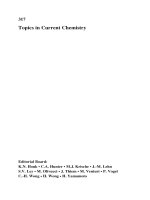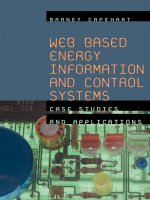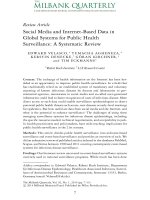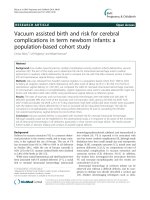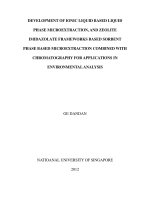Thermosensitive nanocomposite hydrogel based pluronic-grafted gelatin and nanocurcumin for enhancing burn healing
Bạn đang xem bản rút gọn của tài liệu. Xem và tải ngay bản đầy đủ của tài liệu tại đây (838.96 KB, 9 trang )
146
SCIENCE AND TECHNOLOGY DEVELOPMENT JOURNAL:
NATURAL SCIENCES, VOL 2, ISSUE 4, 2018
Thermosensitive nanocomposite hydrogel
based pluronic-grafted gelatin and
nanocurcumin for enhancing burn healing
Huynh Thi Ngoc Trinh, Nguyen Tien Thinh, Ha Le Bao Tran,
Vu Nguyen Doan, Tran Ngoc Quyen
Abstract—Curcumin is extracted from turmeric
exhibiting
several
biomedical
activities.
Unfortunately, less aqueous solubility was still a
drawback to apply it in medicine. This study
introduced a method to produce a thermosensitive
nanocomposite hydrogel (nCur-PG) containing
curcumin nanoparticles (nCur) which can overcome
the poor dissolution of curcumin. Regarding to the
method, a thermo-reversible pluronic F127-grafted
gelatin (PG) play a role as surfactant to disperse and
protect nanocurcumin from aggregation. The
synthetic PG was identified by 1H-NMR. The
obtained results via Transmission Electron
Microscopy (TEM) and Dynamic Light Scattering
(DLS) indicated that the size of nCur was various in
the range from 1.5 ± 0.5 to 128 ± 9.7 nm belong to
amount of the fed curcurmin. The nCur-dispersed
PG solution formed nCur-PG when the solution was
warmed up to 34-35 oC. Release profile indicated
sustainable release of curcumin from hydrogel.
Thermosensitive nanocomposite hydrogel based
pluronic-grafted
gelatin
and
nanocurcumin
performed potential application of the biomaterial in
tissue regeneration.
Index Terms—Nanocurcumin, milling method,
Gelatin, pluronic F127, nanocomposite hydrogel,
medicine
Received: 29-05-2017; Accepted: 10-12-2017
10-12-2018; Published:
15-10-2018.
Author: Huynh Thi Ngoc Trinh1,*, Nguyen Tien Thinh1, Ha
Le Bao Tran2, Vu Nguyen Doan2, Tran Ngoc Quyen1,3 –
1
TraVinh University, 2Institute of Applied Materials Science,
Vietnam Academy of Science and Technology (VAST),
3
University of Science, VNUHCM
(email: )
1 INTRODUCTION
R
ecent years, exploitation of naturally
bioactive compounds has paid much
attention in medicine due to their broad-spectrum
bioactivity such as anti-inflammation, antioxidation, anticancer, wound healing and etc [1].
Among of them, curcumin (1,7-bis (4-hydroxy3-methoxyphenyl)1,6-heptadiene-3,5-dione)
isolated from rhizome of Curcuma longa plant
exhibiting desirable pharmaceutical properties
including anti-inflammatory [2-3], antioxidant
[4-5], anti-tumor [6], anti-HIV [7], antimicrobial activity [8-9], and wound healing
agent [10]. Despite its attractive pharmaceutical
characteristics, low aqueous solubility, poor
bioavailability, rapid metabolism due to the firstpass metabolism [11-13] hampered curcumin in
the journey of wider medical application.
Nanotechnology has been approaching as an
effective solution to improve the bioavailability
of the lipophilic compounds. Nano-formulated
platforms like liposome, micelle, polymeric
nanoparticle and solid lipids have elevated the
therapeutic effects of the hydrophobic drugs
[14]. It is reported that the nano-scaled curcumin
enhanced the dissolution rate [15]. Moreover, the
loaded curcumin could protect it from enzymatic
degradation, enhance water-solubility and
duration blood circulation [16]. Among the
mentioned
platform,
amphiphilic
block
copolymers-based micelles are able to selfassemble for core-shell architecture loading
nanocurcumin. The hydrophobic core is the main
part for encapsulation curcumin in order to
improve the aqueous solubility. Sahu et al [17]
TẠP CHÍ PHÁT TRIỂN KHOA HỌC & CÔNG NGHỆ:
CHUYÊN SAN KHOA HỌC TỰ NHIÊN, TẬP 2, SỐ 4, 2018
was reported that Pluronic micelle could effectively
delivery curcumin for inhibiting Hela cancer cell
growth. Pluronic F127 (Poloxamer 407) is the
thermo-inducible
tri-block
copolymer
of
hydrophilic (poly(ethelene oxide) and lipophilic P
(poly(propylene oxide), with general formula
E107P70E107. The thermo-reversible behavior of
copolymer platform performed sol at 4 oC and gel
at physiological temperature which can be the
micelle-vesicle
for
curcumin-encapsupation.
However, the pluronic-based materials were
general bio-inert so some derivatives were
developed to improve its biological interaction [1819].
The conjugation with gelatin could enhance its
biocompatibility of thermo-responsible hydrogel
solution. Moreover, it could be expected to
increase the interaction between nanocurcumin
(partial negative charge) and the PG copolymer
backbone (partial positive charge) resulting in
enhancing the drug loading efficiency and its
dispersion.
In this present study, we aim to prepare the
thermo-responsive PG copolymer and ultilize it as
the
dispersant
platform
for
fabricating
nanocurcumin in the thermosensitive PG
copolymer solution under the assisted sonication.
The thermo-sensitive nanocomposite hydrogel was
applied to enhance the second degree burn healing.
2 MATERIALS AND METHODS
Materials
Porcine gelatin (bloom 300), pluronic F127 and
curcumin (Cur) were purchased from Sigma
Aldrich
(St.
Louis,
USA).
Mono
pnitrophenylchloroformate-activated pluronic (NPCP-OH) was prepared in our previous study (Nguyen
el al. 2016; Nguyen et al. 2017). Diethyl ether was
obtained from Scharlau’s Chemicals (Spain), THF
tetrahydrofuran (THF) was purchased from Merck
(Germany), and dialysis membranes (MWCO 14
kDa and MWCO 3.5 kDa cut-off) were supplied
from Spectrum Labs (USA),). PBS buffer is
analytical grade.
Synthesis of PG copolymer
147
In a round flask, gelatin (1 gram) was
dissolved in DI water. An aqueous NPC-P-OH
(15 g) solution was added drop-wise to the flask
at 20 oC under stirring overnight. After the time,
the mixture was dialyzed against distilled water
for 3 days using cellulose membrane (MWCO 14
kDa) and lyophilized to have a powder as a
thermo-sensitive copolymer platform for further
study. The copolymer was characterized with 1H
NMR on Bruker AC spectrometer (USA).
PG copolymer was synthesized via a threestep process as show in fig. 1.
Fig. 1. Synthetic scheme of PG copolymer
Sol-gel transition behavior
0.5 mL aqueous copolymer solutions were
prepared from varying PG (ratio of G:P = 1:10,
1:15 and 1:20 wt/wt) at 20 oC. The designated
range temperature was set up at (4, 25, 30, 37, 40
and 50 oC) to determine the sol-gel transition
behavior of nanocomposite hydrogel using the
test tube inversion method which could observe
the “flow as the liquid solution” or “no flow as
the gel formation”. A sol-gel phase diagram was
built regarding to the recorded data.
Fabrication of nCur-dispersed PG copolymer
and its NCur-PG form
2.5 mg curcumin was dissolved in 5 mL
absolute ethanol under sonication. The
suspension was added drop-wise to the PG
copolymer solution (500 mg PG in 2.5 mL DI
water and 5 mL ethanol). Then ethanol solvent
SCIENCE AND TECHNOLOGY DEVELOPMENT JOURNAL:
NATURAL SCIENCES, VOL 2, ISSUE 4, 2018
148
was evaporated by the rotary evaporator to obtain a
homogeneous nCur-loaded PG paste form and cold
DI water was added to obtain thermosensitive
nCur-dispersed PG copolymer solution (as shown
in Fig. 2) that could be transfered into nCur-PG at
warming condition. Morphology of nCur was
observed by TEM (JEM-1400 JEOL) at 25 oC.
Spectral analysis was observed by UV-Vis
spectroscopy
(Agilent
8453
UV-Vis
Spectrophotometer) at 420 nm wavelength. Particle
size distribution was determined using dynamic
light scattering (DLS).
Fig. 2. Preparation of thermosensitivenCur-dispersed PG
copolymer solution
Release study
In the study, a diffusion method with dialysis
membrane was used to investigate the in vitro
release of Cur from the nCur-loaded composite
hydrogel that was prepared from 1 mL of
copolymer (20% w/v) containing 2.5 mg nCur. The
dialysis bag (MWCO 3.5 kDa) containing 2 mL
sample was immersed in 10 mL phosphatebuffered saline (PBS) which had been put over a
period of 24 hours maintained at 37 °C ± 0.5 °C in
a water bath. The Cur content was quantified by the
Foresaid Agilent 8453 UV-Vis Spectrophotometer.
The release experiments were performed in
triplicate with 95% Confidence Interval. The
cumulative release of drug was performed from
equation [20].
Q= CnVt + Vs ∑Cn-1
t, Vt was the incubated medium and Vs was
volume of replaced medium.
Wound healing testing on animal model
Animals: Healthy adult male Mus musculus
var. Albino mice (33–42 g, n = 6) were procured
from the Pasteur Hospital, Ho Chi Minh City,
Vietnam. Mice were maintained in standard
laboratory conditions with add libitum accessto
feed and water, light–dark cycle and adequate
ventilation.
Wound creation: The experiment was
conducted at Laboratory of Department of
Physiology and Animal Biotechnology under the
permission of the Animal Care and Use
Committee of the University of Science,
Vietnam National University Ho Chi Minh City
(Registration No. 10/16-010-00), Vietnam. The
mice were anesthetized by intraperitoneal
ketamine (100 mg/mL) and xylazine (20 mg/mL)
injection with dosage of 0.2 mL/100 g body
weight. The dorsal skin of the animals was
shaved and cleaned with 70% ethanol and 1%
polyvinylpyrrolidone iodine. The secondary burn
degree was created by a cylindrical stainless
steel rod of 1 cm diameter previously heated in
boiling water at 100 °C. The rod is maintained in
contact with the animal skin on the dorsal
proximal region for 5 sec. Thereafter, medication
was initiated for these four groups (nontreatment, dressing PG, nCur-PG copolymer (20
w/v%) containing 2.5 mg nCur and commercial
product/Biafine). Dressings were performed on
each 2 days and finished on days 14. Each mouse
contained two wounds (fig. 3), each medication
was randomly assigned. A photograph of each
wound was taken on days 0, 2, 6, 8, 12 and 14.
Wound size was measured using Caliper (0-200
mm Mitutoyo 530-114). The area of wound
contraction was calculated following the
equation (Jia el al. 2007):
(2)
Where Cn represented the concentration of drug
in sample, Cn-1 was release concentration at
Where li and wi represented for the length
of wound surface at ith day post-wounding.
TẠP CHÍ PHÁT TRIỂN KHOA HỌC & CÔNG NGHỆ:
CHUYÊN SAN KHOA HỌC TỰ NHIÊN, TẬP 2, SỐ 4, 2018
149
Fig. 3. Experimental design on animal model
Statistical analysis: Data were represented as
means ± standard error (n = 3). ANOVA two
ways (SPPS software) was used for the analysis of
cytotoxicity on fibroblast cells and wound
contraction. A p-value <0.05 was accepted as a
statistically significant difference.
3 RESULTS AND DISCUSSION
Characterization of copolymers
1
H NMR spectrum of the activated NPC-PNPC appeared a prominent resonance peak at δ=
4.42 and two peaks at 7.38–8.22 ppm that
corresponded to the signal of protons on the
terminal methylene (-CH2-CH2-) in the activated
plruronic and aromatic NPC protons, respectively.
Activated degree of NPC-P-NPC was over 95%
(1H NMR). In spectrum of NPC-P-OH, one new
peak at δ= 4.22 assigned to terminal methylene
protons (-CH2-CH2-) in the NPC-substituted
moiety of the activated pluronic. These evidences
confirmed that NPC-P-NPC and NPC-P-OH were
successfully prepared (spectra not shown here)
[22].
Pluronic-grafted gelatin (PG) was created via
urethane linkage between amine groups on gelatin
backbone and NPC-remaining moiety of NPC-POH. In the PG spectrum, the resonance peak at
7.23–7.29 ppm indicated aromatic protons of
phenylalanine and other typical protons of
aminoacids in gelatin as noted in fig. 4. Some
protons of the pluronic (-CH3 of PPO at 1.08 ppm
and -CH2 of PEO at 3.6 ppm) also appeared in the
spectrum. Moreover, a disappearance of aromatic
proton (NPC) at 7.38–8.22 ppm confirmed the
substitution of NPC by the primary amine of
gelatin to form PG copolymer.
Fig. 4. 1H NMR spectrum of PG copolymer
Thermo-reversible behavior
Phase diagram of sol-gel transition behavior
in Fig. 5 indicated the phase conversion of four
samples of PG, which were different in weight
ratio of gelatin and pluronic (PG 1:5, PG 1:10,
PG 1:15, PG 1:20). The gelation temperature
depended on the ratio of pluronic grafted to
gelatin. A lowest gelation temperature of PG 1:5
150
SCIENCE AND TECHNOLOGY DEVELOPMENT JOURNAL:
NATURAL SCIENCES, VOL 2, ISSUE 4, 2018
was seen in the Fig. 5A, corresponding to the
property of gelatin that formed gel at low
temperature and dissolved at room temperature.
As increasing content of pluronic in the grafted
copolymer (PG 1:10, PG 1:15 and PG 1:20), the
gelation behavior was partially followed to the
thermal property of pluronic. For PG 1:10
sample, the gelation occurred when its
concentration was higher 12.5 % (wt/v) at 30 oC,
but its physical property was weak. At a same
temperature, PG 1:15 and PG 1:20 occurred
gelation at lower concentration of PG copolymer
(around 10% (w/v)) and the formed gels were
high stable at 15% (w/v) of PG which could be
used for further studies. The gel “phase” occurred
due to hydrophobic effect [23, 24], attributed
self-assembly and coil to helix converting for
conformation altering caused the “solid-like gel”
at critical micelle concentration under critical
solution temperature. The sol-gel transition of the
copolymer solution could be observed with DSC
measurement as shown in Fig. 5B, in which
maximally exothermic peak at 36.27 oC (ranging
from 28 to 40 oC) performed a solidification of
the PG solution. The phase diagram also showsed
that temperature ranges of the PG copolymer
solution was a homogeneous phase. This
behavior was near similar to a report from Barba
A. A. et al [25] who investigated the sol-gel
transition behavior of pluronic [25].
Fig. 5. A) Phase diagram of sol-gel transition behavior of PG copolymer solution, B) DSC signal recorded following
heating/cooling process of solution at 15% wt/v of PG
Characterization of the nanocurcuminloaded thermogel
Several reports indicated that nano-scaled
curcumin could enhance the cellular absorption
and biodistribution of the hydrophobic molecule
[26]. So some methods have been introduced to
formulate nanocurcumin such as ultrasonication,
milling, using surfactant and etc. Our study used
an ultrasonic and PG dispersant combination
method to produce nanocurcumin suspension. It
was more interesting that the nanosuspension
solution could form the nanocomposite hydrogel
when the suspension was warmed up (fig. 6). The
nanocurcumin could form in the PG copolymer
solution and the PG copolymer contributed to the
stability the nanocurcuminin hydrophobic domain
of PG [27]. Moreover, Zeta potential
measurement showed the positively charged PG
copolymer
and
the
negatively charged
nanocurcumin (data not shown here) which could
offer a significant role of gelatin in enhancing
stability of nanocurcumin due its electrostatic
interaction. The effect of curcumin formulations
on the size distribution of nanocurcumin were
evaluated by TEM (fig. 7) and DLS (fig. 8) at
4 oC that indicated the size of the round-shaped
nanocurcumin significantly varied ranging from 7
to 258 nm belonging to the amount of loaded
curcurmin formulated with PG copolymer. DLS
revealed that the hydrodynamic diameter of nanoparticles was a function of concentration. A
higher concentration of the fed curcumin, afforded
TẠP CHÍ PHÁT TRIỂN KHOA HỌC & CÔNG NGHỆ:
CHUYÊN SAN KHOA HỌC TỰ NHIÊN, TẬP 2, SỐ 4, 2018
151
larger size diameter. The formed nanoparticles
was 7 ± 0.5 nm (5% wt/wt), 16 ± 3.2 nm (10%
wt/wt), 26 ± 10.3 nm (15% wt/wt), 128 ± 8.8 nm
(20% wt/wt) and 258 ± 9.7 nm (30% wt/wt). In
particularly, the incorporation of nanocurcumin
did not affect the thermal-reversible behavior of
PG responsible- hydrogel.
Fig. 7. TEM image of nanocurcumin dispersed in PG 1:15
with 5% wt/wt curcumin
Fig. 6. Sol-gel transition of nCur-PG hydrogel
Fig. 8. Particle size distribution of nanocurcumin at different concentration with PG in solution of 5% w/w (a), 10% w/w (b),
15% w/w (c), 20% w/w (d), 30% w/w (e)
SCIENCE AND TECHNOLOGY DEVELOPMENT JOURNAL:
NATURAL SCIENCES, VOL 2, ISSUE 4, 2018
152
In vitro release study
In order to investigate the controllable delivery
manner of the thermosensitive nanocurcuminloaded PG platform, the in vitro release study was
performed using a diffusion method with dialysis
membrane. Fig. 9 depicts the release profile of
nanocurcumin for 24 hours. In detail, for the first
2 hours only 5% drug released, whereas, curcumin
delivery was for the later 3 hours reached up 50%,
subsequently exhibited a constant rate of release
was 74.66 ± 3.9%. The graph elucidates the
mediated nanocurcumin release fashion over time,
provided the potential matrix for drug delivery to
the site administration.
Burn healing evaluation
Fig. 10 indicated that the PG-treated wound
exhibited a faster wound healing rate than that of
control, but healing was slower than the rates
observed in nCur-PG and commercial dressings.
The nCur-PG model described that the wound
recovery was faster than other groups.
Macroscopically, the wounds were almost closed
at 10 days, and appeared as scar tissues 14 days
after treatment. There was no obviously difference
in the speed of wound closure among the models
during the 14 day follow-up period, except the
non-treatment wounds with. After 14 days, only
the group nCur-PG showed the new hair on
wound surface and the similar skin color of other
skin area on mice, while in non-treatment model,
all wounds have epithelialized and a raised
hypertrophic scar was visible. No hair on the
wound surface or hypertrophic scar in the PG gel
and commercial product-treated models. This
obtained results suggested that the presentation of
nanocurcumin accelerated the wound healing
process. It was marked by wound area reduction
and wound recovery.
Fig. 9. Release profile of nanocurcumin in Pggel
Fig. 10. Macroscopic image of wound surface in animal model at 2, 8 and 14 post treatment and wound contraction after
14 days. The error bar was presented by +/-SE
4 CONCLUSION
We
successfully
synthesized
a
thermosensitive
pluronic-grafted
gelatin
copolymer served as a dispersant to produce
small size of nanocurcumin (lower than 20 nm)
or high nanocurcumin content (up to 30
wt/wt%) with the feeded copolymer. The nCurdispersed PG copolymer solution could form a
nanocomposite hydrogel at the physiological
temperature (around 35 oC). Sustainable release
profile of curcumin from the hydrogel matrix
TẠP CHÍ PHÁT TRIỂN KHOA HỌC & CÔNG NGHỆ:
CHUYÊN SAN KHOA HỌC TỰ NHIÊN, TẬP 2, SỐ 4, 2018
provided the desirable vehicle to control the
delivery of curcumin at a suitable concentration
for enhancing wound healing (low concentration
of encapsulated curcumin) or inbibiting the
growth of cancer cell (high concentration of
encapsulated curcumin). These obtained results
could be pave a way to apply the
thermosensitive nanocurcumin-loaded platform
in biomedical field.
Acknowledgements:
This work was
financially supported by Tra Vinh University
under Grant Number 1434/HD.DHTV-KHCN
and Vietnam Academy of Science and
Technology (VAST) under Grant Number
VAST03.08/17-18.
[10].
[11].
[12].
[13].
[14].
[15].
REFERENCES
[1].G.C. Jagetia, B.B. Aggarwal, Spicing up of the immune
system by curcumin, J. Clin. Immunol., 27, 1, 19–35,
2007.
[2].R.C. Srimal, B.N. Dhawan, Pharmacology of diferyloyl
methane
(curcumin),
a
non-steroidal
antiinflammatory agent, J. Pharm. Pharmacol., 25, pp.
447–452, 1973.
[3].B.B. Aggarwal, K.B. Harikumar, Potential therapeutic
effects of curcumin, the anti-inflammatory agent,
against neurodegenerative, cardiovascular, pulmonary,
metabolic, autoimmune and neoplastic diseases, Int J
Biochem Cell Biol, 41, 40–59, 2009.
[4].Y. Sugiyama, S. Kawakishi, T. Osawa, Involvement of
the diketone moiety in theantioxidativemechanism of
tetrahydrocurcumin, Biochem Pharmacol, 52, 519–
525, 1996.
[5].P. Pizzo, C. Scapin, M. Vitadello, C. Florean, L. Gorza,
Grp94 acts as a mediator of curcumin-induced
antioxidant defense in myogenic cells, J. Cell Mol.
Med., 14, 970–81, 2010.
[6].Y.K. Lee, W.S. Lee, J.T. Hwang, D.Y. Kwon, Y.J. Surh,
O.J. Park, “Curcumin exerts anti-differentiation effect
through AMPKalpha-PPAR-gamma in 3T3-L1
adipocytes and antiproliferatory effect through
AMPKalpha-COX-2 in cancer cells, J. Agric. Food
Chem., vol. 57, pp. 305–10, 2009.
[7].W.C. Jordan, C.R. Drew, “Curcumin-A natural herb
with anti-HIV activity”, J. Natl. Med. Assoc., vol. 88,
no.6, pp. 333–34, 1996.
[8].D. Ronita, K. Parag, S. Snehasikta, T. Ramamurthy, C.
Abhijit, G.B. Nair, K.M. Asish, Antimicrobial activity
of curcumin against Helicobacter pylori isolates from
India and during infections in mice, Antimicrob
Agents Chemother, 53, 4, 1592–97, 2009.
[9].Y. Wang, Z. Lu, H. Wu, F. Lv, Study on the antibiotic
activity of microcapsule curcumin against foodborne
[16].
[17].
[18].
[19].
[20].
[21].
[22].
[23].
[24].
153
pathogens, Int. J. Food Microbiol., 136, 1, 71–4,
2009.
R.K. Maheshwari, A.K. Singh, J. Gaddipati, R.C.
Srimal, Multiple biological activities of curcumin: a
short review, Life Sci., 78, 18, 2081–87, 2006.
P. Anand, A.B. Kunnumakkara, R.A. Newman, B.B.
Aggarwal, Bioavailability of curcumin: problems and
promise, Mol. Pharm., 4, 6,. 807–18, 2007.
R.A. Sharma, W.P. Steward, A.J. Gescher,
Pharmacokinetics
and
pharmacodynamics
of
curcumin, Advances in Experimental Medicine and
Biology, 595, 453–70, 2007.
A. Asaiand, T. Miyazawa, Occurrence of orally
administered curcuminoid as glucuronide and
glucuronide/sulfate conjugates in rat plasma”, Life
Sci., 67, 2785–93, 2000.
M. Sun, X. Su, B. Ding, X. He, X. Liu, A. Yu, H. Lou,
G. Zhai, Advances in nanotechnology-based delivery
systems for curcumin. Nanomedicine (Lond), 7, 7,
1085–100, 2012.
F. Kesisoglou, S. Panmai, Y. Wu, Nanosizing–oral
formulation development and biopharmaceutical
evaluation, Adv. Drug Deliv. Rev., 59, 7, 631–44,
2007.
R.A.Jr.
Freitas,
What
is
nanomedicine?,
Nanomedicine: Nanotechnology, Biology, and
Medicine, 1, 1, 2–9, 2005.
A. Sahu, N. Kasoju, P. Goswami, U. Bora,
Encapsulation of curcumin in pluronic block
copolymer micelles for drug deliveryapplications, J.
Biomater. Appl., 25, 6, 619–39, 2011.
L. Zhang, D.L. Parsons, C. Navarre, U.B. Kompella,
Development and invitro evaluation of sustained
release Poloxamer 407 gel formulation of ceftiofur, J.
Control Rel., 85, 73–81, 2002.
A. Higuchi, K. Sugiyama, B.O. Yoon, M. Sakurai, M.
Hara, M. Sumita, S. Sugawara, T. Shirai, Serum
protein adsorption andplatelet adhesion on pluronicadsorbed polysulfone membranes, Biomaterials, 24,
3235–45, 2003.
W.J. Jia, J.G. Liu, Y..D Zhang, et al. Preparation,
characterization, and optimization of pancreastargeted 5-Fu loaded magnetic bovine serum albumin
microspheres, J. Drug Target, 15, 140–45, 2007.
I.R. Lymam, J.H. Tenery, and R.P. Basson,
Correlation between decrease in bacterial load and
rate of wound healing, Surg. Gynecol. Obstet, 130,
616–620, 1970.
T.B.T. Nguyen, L.H. Dang, N.Q. Tran, et al. Green
processing of thermosensitive nanocurcuminencapsulated chitosan hydrogel towards biomedical
application, Green Processing and Synthesis, vol. 5,
pp. 511–520, 2016.
H.G.
Schild,
Poly(N-isopropylacrylamide):
Experiment, theory and application, Prog. Polym. Sci.,
17, 163–249, 1992.
N.T. Southall, K.A. Dill, A.D.J. Haymet, A view of
the hydrophobic effect, J. Phys. Chem. B, 106, 3, 521–
33, 2002.
SCIENCE AND TECHNOLOGY DEVELOPMENT JOURNAL:
NATURAL SCIENCES, VOL 2, ISSUE 4, 2018
154
[25]. A.A. Barba, M. d’Amore, M. Grassi, S. Chirico, G.
Lamberti, G. Titomanlio, Investigation of Pluronic©
F127–Water solutions phase transitions by DSC and
dielectric spectroscopy, J. Appl. Polym. Sci., 114, 2, 688–
95, 2009.
[27]. M.M. Yallapu, M. Jaggi, and S.C. Chauhan, “Curcumin
nanoformulations: a future nanomedicine for cancer”,
Drug Discov. Today, 17, 1–2, 71–80, 2012.
[26]. SS. Feng, Nanoparticles of biodegradable polymers for
new concept chemotherapy, Expert. Rev. Med. Devices, 1,
1, 115–25, 2004.
Hydrogel nanocomposite nhạy nhiệt từ
pluronic-grafted gelatin mang
nanocurcumin ứng dụng trong chữa lành
vết thương
Huỳnh Thị Ngọc Trinh1,*, Hà Lê Bảo Trân2, Vũ Nguyên Doan2,
Trần Ngọc Quyên1,3
1
2
TraVinh University,
Institute of Applied Materials Science, Vietnam Academy of Science and Technology (VAST),
3
University of Science, VNU-HCM
*Corresponding author:
Ngày nhận bản thảo: 29-05-2017; Ngày chấp nhận đăng: 10-12-2017;
10-12-2018, Ngày đăng:15-10-2018
Tóm tắt—Curcumin là một hợp chất được chiết
xuất từ củ nghệ có nhiều hoạt tính sinh học. Tuy
nhiên, tính kỵ nước cao đã làm hạn chế ứng dụng
của nó trong dược dụng. Nghiên cứu đưa ra phương
pháp điều chế một loại hydrogel nhạy nhiệt có chứa
curcumin ở kích thước nano (nCur - PG) để cải
thiện đặc tính kém tan trong nước của curcumin.
Phương pháp này sử dụng pluronic F127 nhạy nhiệt
ghép với gelatin (PG) đóng vai trò như chất hoạt
động bề mặt để phân tán và ngăn chặn sự kết tụ của
hạt nanocurcumin. Cấu trúc của copolymer PG
được xác định bằng phổ cộng hưởng từ hạt nhân
1H-NMR. Kích thước hạt nanocurcumin trong
hydrogel được xác định bằng kính hiển vi điện tử
truyền qua (TEM) và tán xạ ánh sáng động học
(DLS) cho thấy hạt nano phân bố từ 1,5 ± 0,5 đến
128 ± 9,7 nm tùy hàm lượng curcumin sử dụng. Hạt
nanocurcumin được phân tán trong dung dịch
copolymer PG sẽ tạo thành hệ hydrogel khi nâng
nhiệt độ lên 34-35 oC. Đường cong nhả thuốc đã
chứng minh khả năng nhả chậm curcumin của
hydrogel. Hydrogel nanocomposite nhạy nhiệt
gelatin - pluronic F127 mang nanocurcumin có tiềm
năng là vật liệu y sinh ứng dụng trong lĩnh vực tái
tạo mô.
Từ khóa—Nanocurcumin, phương pháp nghiền, gelatin, pluronic F127, hydrogel nanocomposite, thuốc


